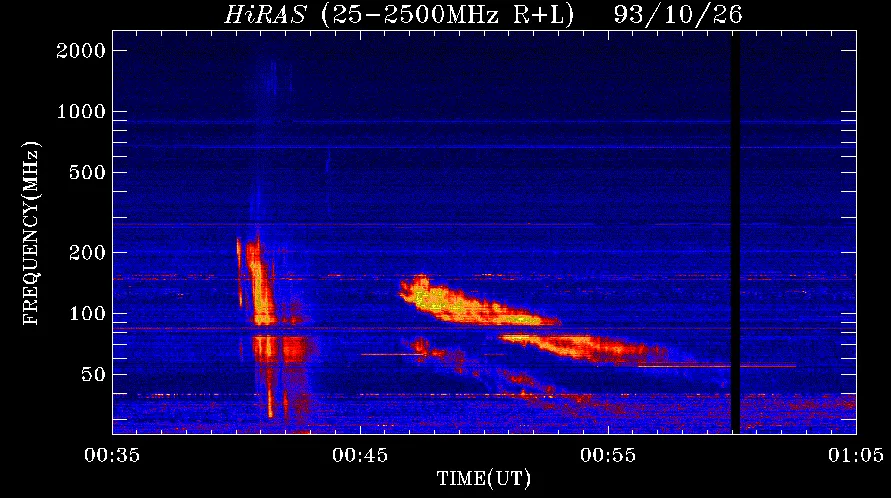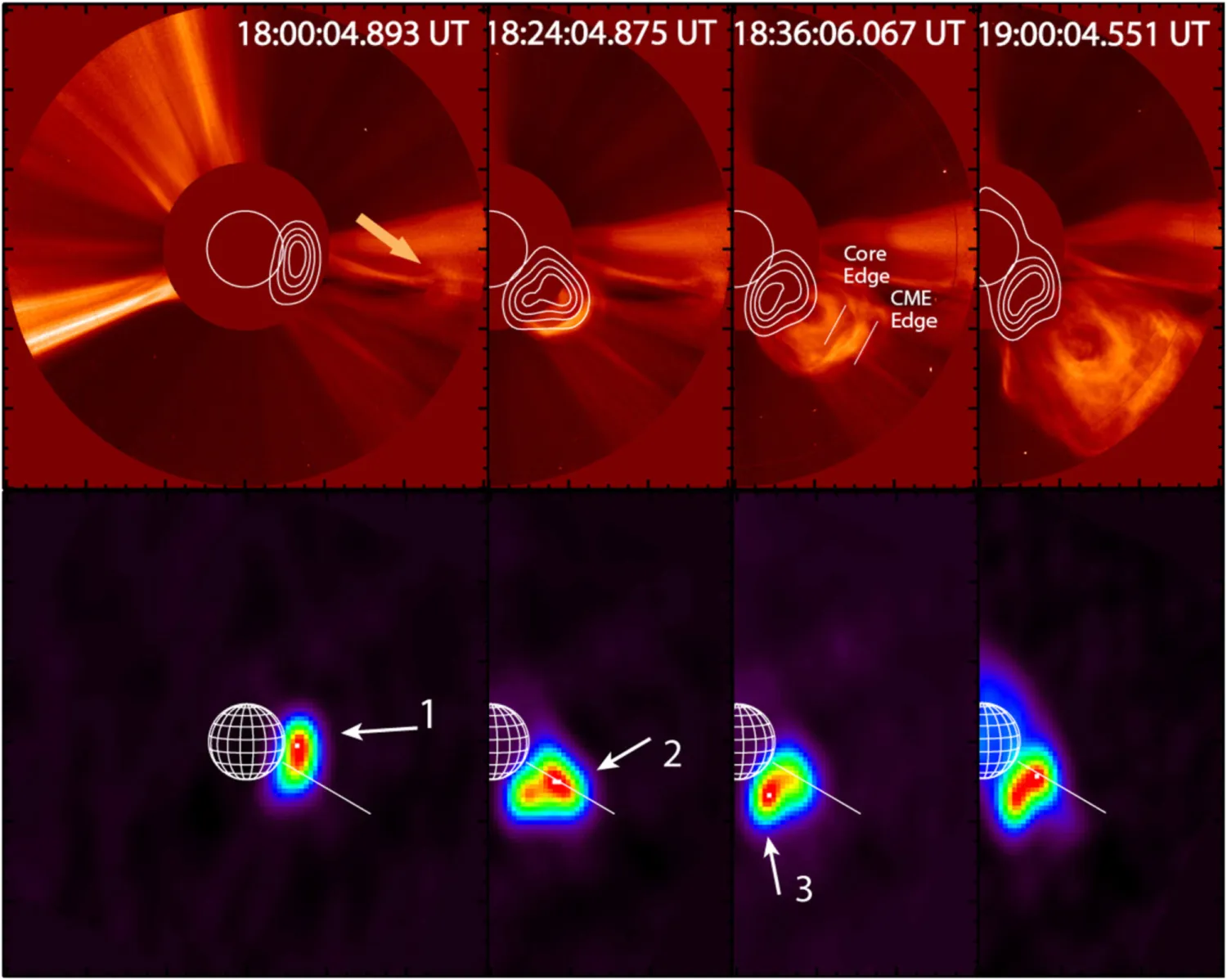Solar Radio Bursts: Noisy Signals from the Sun’s Surface

Solar radio bursts, those fleeting crackles of electromagnetic energy erupting from our star, are more than just cosmic noise—they’re a window into the Sun’s dynamic behavior.
Anúncios
These intense emissions, often tied to solar flares and coronal mass ejections (CMEs), reveal the chaotic physics of the Sun’s surface and its influence on space weather.
For astronomers, these bursts are like a symphony of chaos, each note carrying clues about solar activity and its impact on Earth.
Why do these bursts matter? Because understanding them could unlock better predictions for satellite disruptions, astronaut safety, and even power grid stability.
Moreover, solar radio bursts can also provide insight into the Sun’s internal processes and magnetic field dynamics.
By analyzing these signals, scientists can better understand the mechanisms driving solar activity, which is crucial for predicting space weather events that affect Earth.
The Science Behind the Static
Picture a solar radio burst as a cosmic tantrum, where the Sun hurls energy across the radio spectrum in sudden, powerful spikes.
These bursts originate from the Sun’s outer layers, particularly the corona, where magnetic fields twist, snap, and release pent-up energy.
When charged particles, like electrons, spiral through these magnetic fields, they emit radio waves detectable by ground-based observatories.
The bursts vary in intensity and frequency, ranging from faint whispers to deafening roars that drown out other signals.
A 2023 study from the National Solar Observatory revealed that solar radio bursts often correlate with high-energy particle events, with 68% of Type III bursts linked to solar flares.
This statistic underscores their role as markers of solar unrest.
Unlike visible light, which shows us the Sun’s surface, these radio signals let us eavesdrop on processes deep within the solar atmosphere, offering a unique diagnostic tool.
Furthermore, understanding these radio emissions can help improve our models of solar dynamics.
By correlating radio burst data with other solar observations, researchers can refine their predictions about solar behavior and its effects on space weather.
| Type | Frequency Range | Typical Duration | Associated Phenomena |
|---|---|---|---|
| Type II | 10–200 MHz | Minutes | Coronal Mass Ejections (CMEs) |
| Type III | 0.1–100 MHz | Seconds | Electron Beams, Solar Flares |
Table 1: Common Types of Solar Radio Bursts and Their Characteristics
A Cosmic Symphony of Chaos
Imagine the Sun as a restless composer, its magnetic fields the strings of an instrument played with reckless abandon.
Solar radio bursts are the discordant notes, each type revealing a different mood of the Sun.
Type II bursts, for instance, signal the shockwaves of CMEs barreling through space, potentially disrupting Earth’s magnetosphere.
Type III bursts, on the other hand, are fleeting, tied to streams of electrons racing along magnetic field lines.
These differences aren’t just academic—they help scientists predict how solar activity might ripple across the solar system.
Consider the 2017 solar event, when a Type III burst preceded a geomagnetic storm that knocked out radio communications in parts of North America.
Observatories like the Expanded Owens Valley Solar Array (EOVSA) captured the burst’s signature, allowing researchers to trace its origins to a flare in Active Region 12673.
This example shows how bursts act as early warning signals, giving us a head start on space weather forecasting.
Additionally, studying these bursts can lead to advancements in our understanding of solar-terrestrial interactions.
As scientists decode the information carried by these signals, they can enhance models that predict how solar activity affects Earth’s atmosphere and technology.
+ Solar Prominences: Loops of Plasma and Magnetic Energy
Why Solar Radio Bursts Demand Our Attention
The Sun’s outbursts aren’t just a spectacle for astronomers—they’re a practical concern.
Solar radio bursts can interfere with GPS signals, aviation communications, and even military radar systems.
In a world increasingly reliant on technology, these disruptions are more than inconveniences; they’re potential threats to infrastructure.
For instance, a powerful burst in 2022 temporarily scrambled GPS signals over the Pacific, affecting maritime navigation for hours.
This real-world impact highlights the urgency of studying these phenomena.
Beyond practical concerns, these bursts challenge our understanding of plasma physics.
The Sun’s corona, where bursts originate, is a scorching 1 million degrees Celsius, yet it’s far hotter than the surface below.
How does this temperature inversion happen?
Solar radio bursts offer clues, as their emissions are tied to the magnetic reconnection events that heat the corona.
By decoding their signals, we edge closer to solving this solar mystery.
To delve deeper into the implications of solar activity on technology, check out NASA’s Solar Dynamics Observatory, which provides extensive resources and data on solar phenomena.

| Impact | Affected Systems | Mitigation Strategies |
|---|---|---|
| Radio Communication | HF Radio, Aviation, Military Radar | Backup Frequencies, Signal Redundancy |
| GPS Disruption | Navigation, Maritime, Autonomous Systems | Inertial Navigation, Multi-Constellation GNSS |
Table 2: Impacts of Solar Radio Bursts and Mitigation Strategies
The Tools We Use to Listen
Catching a solar radio burst requires sophisticated instruments.
Radio telescopes, like the Low-Frequency Array (LOFAR) in Europe, are tuned to detect the low-frequency waves emitted during these events.
These arrays act like giant ears, capturing signals from across the radio spectrum.
Newer facilities, such as the Square Kilometre Array (SKA), promise even greater sensitivity, potentially revolutionizing our ability to map bursts in real time.
But it’s not just about hardware.
Advanced algorithms now sift through the noise, identifying burst signatures with machine learning.
These tools can distinguish a Type II burst from a Type III in seconds, a task that once took hours.
This leap in processing power means we’re not just hearing the Sun—we’re starting to understand its language.
Moreover, the integration of multiple observational techniques enhances our understanding of solar events.
By combining data from radio telescopes with X-ray and ultraviolet observations, scientists can create a comprehensive picture of solar activity.
The Broader Cosmic Context
Solar radio bursts don’t exist in isolation; they’re part of a larger cosmic conversation.
Similar radio emissions have been detected from distant stars, hinting that our Sun’s behavior might be typical of other stellar systems.
By studying these bursts, we’re not just learning about our star but also about the magnetic dynamics of stars across the galaxy.
This comparative approach could reshape our understanding of stellar evolution.
For example, a hypothetical star, let’s call it Solara, 50 light-years away, might produce bursts akin to our Sun’s Type III emissions.
If we detect these with future observatories, we could infer Solara’s magnetic activity, offering insights into its habitability for orbiting planets.
This speculative scenario shows how solar radio bursts serve as a bridge between solar and stellar science.
Additionally, examining radio emissions from various stars can provide clues about the formation and evolution of planetary systems.
Understanding the commonalities and differences in stellar behavior can enhance our knowledge of how life-supporting conditions develop in the universe.

Challenges in Decoding the Noise
Despite their value, solar radio bursts are tricky to study.
Their signals are often drowned out by terrestrial interference—think cell phone towers or Wi-Fi networks.
Isolating a burst’s signature requires meticulous calibration, a task that pushes the limits of current technology.
Moreover, bursts are unpredictable, often lasting mere seconds, making real-time observation a logistical challenge.
Then there’s the issue of data volume.
A single observing session with a radio telescope can generate terabytes of data.
Sifting through this for meaningful signals is like finding a needle in a digital haystack.
Yet, these challenges drive innovation, spurring advancements in data processing and telescope design.
Furthermore, collaboration among international research teams can enhance data collection and analysis.
Sharing resources and expertise allows for a more comprehensive understanding of solar radio bursts and their implications.
++ The End of the Sun: When and How Our Star Will Die, According to Science
The Future of Solar Radio Burst Research
What’s next for studying these cosmic signals?
The answer lies in integration.
Combining radio observations with X-ray, ultraviolet, and visible light data paints a fuller picture of solar activity.
Upcoming missions, like NASA’s SunRISE (Sun Radio Interferometer Space Experiment), aim to deploy multiple small satellites to create a virtual radio telescope in orbit.
This could map bursts with unprecedented precision, offering 3D views of their origins.
Public engagement is also key.
Citizen science projects, like those hosted by Zooniverse, let enthusiasts analyze burst data, democratizing discovery.
Imagine a high school student spotting a Type II burst that heralds a CME—such moments could inspire the next generation of astronomers.
Moreover, fostering educational programs around solar science can cultivate interest and awareness among the public.
By encouraging young people to engage with astronomy, we can inspire future scientists and innovators.
A Call to Listen to the Sun
Why should we care about the Sun’s noisy outbursts?
Because they remind us of our star’s power and unpredictability.
Solar radio bursts are more than scientific curiosities; they’re signals that connect us to the cosmos, urging us to refine our tools, deepen our understanding, and prepare for the Sun’s next move.
As we tune in to these bursts, we’re not just listening to the Sun—we’re learning to anticipate its whims, safeguarding our technology and expanding our cosmic perspective.
By embracing the study of solar radio bursts, we can enhance our preparedness for space weather events and their impacts on our planet.
Ultimately, this knowledge fosters a deeper connection to our universe and the dynamic forces at play within it.
